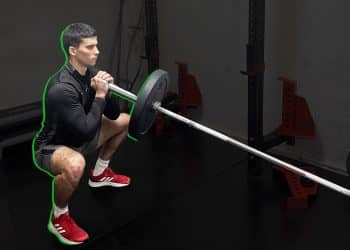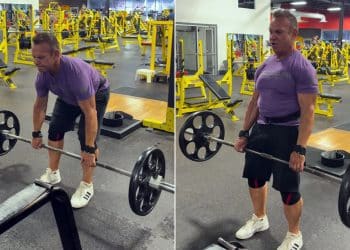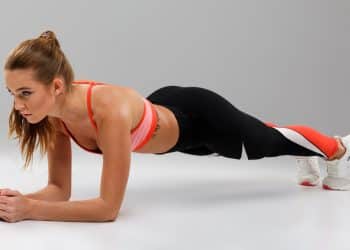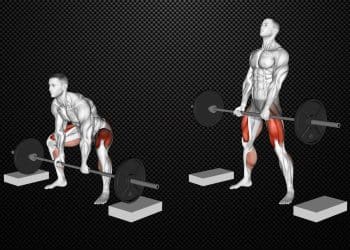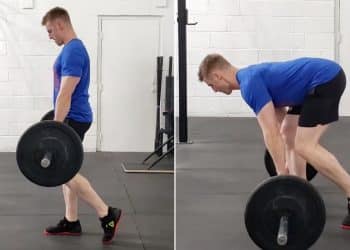Landmines are incredibly versatile training tools. In more than a few instances, landmine exercises are easier to learn and more joint-friendly than their barbell or dumbbell counterparts. You can use a landmine for upper body, core, and lower body training.
A landmine is simply a barbell with a hinge at one end. No landmine? No problem! You can replicate most landmine exercises simply by putting the end of a regular barbell in a corner.
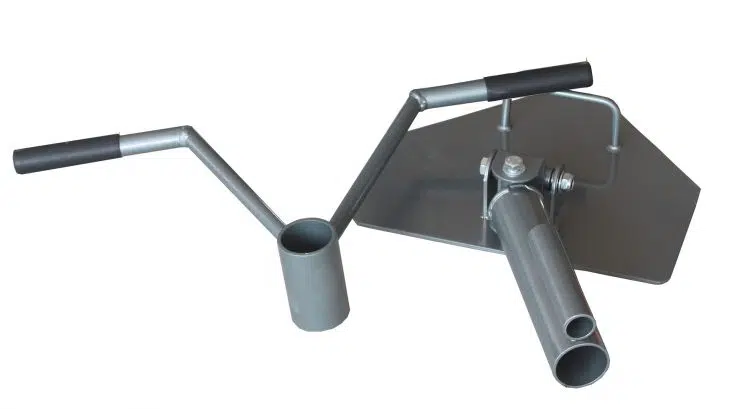
The landmine Romanian deadlift (RDL) is a great posterior chain exercise and every bit as effective as regular barbell RDLs. Some lifters may even find them more comfortable and lower back-friendly.
In this article, we reveal why and how to do landmine RDLs, and provide you with seven of the best alternatives to this excellent muscle and strength builder.
Landmine RDLs – Muscles Worked
Landmine RDLs are a compound exercise that involves several major muscles:

Level Up Your Fitness: Join our 💪 strong community in Fitness Volt Newsletter. Get daily inspiration, expert-backed workouts, nutrition tips, the latest in strength sports, and the support you need to reach your goals. Subscribe for free!
Hamstrings
Located on the back of your thighs, your hamstrings are a biarticular muscle which means they cross two joints; the hips and the knees. As such, they affect both these joints. The hamstrings extend your hips and also flex your knees. The three hamstring muscles are the biceps femoris, semimembranosus, and semitendinosus.
Gluteus maximus
Known as your glutes for short, this is the largest muscle in the human body. Its primary function is hip extension, although it also plays a part in hip abduction and rotation.
Erector spinae
This is the collective term for the three muscles that run up either side of your spine; the spinalis, longissimus, and iliocostalis. Their main function is the extension of your spine. But, in landmine RDLs, they contract isometrically (statically) to prevent lumbar flexion.
Core
These midsection muscles contract inward to create intra-abdominal pressure and stabilize your spine during landmine RDLs. A lack of core strength could mean your lumbar spine rounds during RDLs, and that could lead to injury. Brace your core to avoid this issue.
Trapezius and rhomboids
Located across your upper back and between your shoulder blades, these muscles contract to pull your shoulders down and back to stabilize your shoulder girdle.
How to Do Landmine RDLs
Get more from landmine RDLs while keeping your risk of injury to a minimum by following these guidelines:
- Stand at the end of your landmine bar. Your feet should be between shoulder and hip-width apart.
- Bend your knees and squat down. Cup the end of the landmine bar in your hands, interlacing your fingers if you wish.
- Brace your abs, pull your shoulders down and back and, with straight arms, stand up straight. Bend your knees slightly and then keep them rigid. This is your starting position.
- Push your hips backward and hinge forward from your hips. Keep your arms straight, and do not round your lower back.
- Lean as far forward as your hamstring flexibility allows.
- Drive your hips forward and stand back up.
- Repeat for the prescribed number of reps.
- Squat down and return the weight to the floor on completion, taking care not to round your lumbar spine.
Landmine RDL Benefits and Drawbacks
Not sure if landmine RDLs deserve a place in your workouts? Consider these benefits!
Lower back-friendly
Landmine RDLs are more lower back-friendly than barbell RDLs. The weight is very close to your legs, which takes stress off your lumbar spine. This is a good exercise for anyone looking to avoid lower back pain.
Increased posterior chain engagement
As you lean forward during landmine RDLs, the end of the bar gets closer to your legs. This forces you to push your hips back, which increases glute and hamstring activation. Because of this, landmine RDLs may be more effective than the regular barbell variety for some exercisers.
Less balance required
With one end of the bar fixed in place, landmine RDLs involve less balance and coordination than the regular version. This means they may be better for beginners. Also, they’re good for more advanced exercisers who want to focus on lifting heavy weights to build maximal strength.
While landmine RDLs are a mostly beneficial exercise, there are also a few drawbacks to consider:
Lack of equipment
Landmine RDLs work best when done with a landmine training apparatus. You can do them with a barbell wedged into a corner, but this is not always convenient. Not having a landmine or barbell could mean that you are unable to do this exercise.
Uncomfortable grip
Whether you use an interlaced or regular grip for landmine RDLs, you may find holding the bar awkward or even painful. The end of a landmine bar is quite thick, which could mean that your grip fails before the target muscles.
A tendency to round your lower back
Landmine RDLs should be done with a neutral spine, i.e., a slightly arched lower back. Some exercisers will be unable to do this and could end up rounding their lower back. A rounded lower back is weak and prone to injury. Maintaining a neutral lumbar spine during landmine RDLs requires a strong core, good hamstring flexibility, and well-developed postural awareness.
7 Landmine RDL Variations and Alternatives
Landmine RDLs are a highly effective posterior chain exercise, but that doesn’t mean you need to do them all the time. There are several variations and alternatives you can use to keep your workouts productive and interesting:
1. Barbell/Dumbbell RDLs
While landmine RDLs are a valuable alternative to regular RDLs, that doesn’t mean this exercise is no longer valid or useful. You can still do RDLs with a barbell or dumbbells. Providing you hinge from your hips and avoid rounding your lower back, barbell and dumbbell RDLs are both safe and effective posterior chain exercises.
Level Up Your Fitness: Join our 💪 strong community in Fitness Volt Newsletter. Get daily inspiration, expert-backed workouts, nutrition tips, the latest in strength sports, and the support you need to reach your goals. Subscribe for free!
Read more about Romanian deadlifts here.
2. Single-leg Romanian Deadlifts
It’s all too easy to use one leg more than the other during landmine RDLs, particularly because the weight follows a fixed path. Avoid and fix left-to-right strength imbalances by doing unilateral or single-leg Romanian deadlifts. As well as being helpful for correcting strength imbalances, this exercise is good for flexibility, coordination, and balance. It’s also very lower back-friendly.
Learn how to do single-leg Romanian deadlifts here.
3. Single-leg Landmine RDLs
If single-leg RDLs have a disadvantage, it is that lack of balance can stop you from lifting heavy weights and developing maximal muscle strength and size. Single-leg landmine RDLs make balancing considerably easier, leaving you free to focus on overloading your muscles but still able to work one leg at a time.
How to do it:
- Stand side-on to the end of your landmine bar. Squat down and grab the handle with your closest hand. Stand up straight.
- Shift your weight onto your outside leg. Brace your core and pull your shoulder down and back.
- Bend your supporting knee slightly, hinge from your hips, and lean forward as far as your hamstring flexibility allows. Do not round your lower back. Simultaneously extend your other leg out behind you for balance.
- Stand back up and repeat.
- Do the same number of reps on both legs.
You can also do this exercise with the landmine in front of you, but this tends to make balancing a little more challenging.
4. Cable Pull-Throughs
You don’t need a landmine or even a barbell or dumbbells to train your posterior chain with hip hinges. A cable machine will suffice! Cable pull-throughs work the same muscles as landmine RDLs and are even more lower back-friendly.
As an added benefit, muscle tension increases as you complete each rep, so you’ll really feel this exercise in your glutes and hamstrings. Cable pull-throughs are a popular powerlifting accessory exercise.
- Attach a rope handle to a low pulley machine. Stand with your back to the weight stack, feet astride the handle.
- With your abs braced and shoulders down and back, bend down and grab the handle with both hands. Stand up and take a couple of steps forward to tension the cable.
- Stand with your feet shoulder-width apart, knees slightly bent, hands in front of your hips. This is your starting position.
- Push your hips back and lean forward until you feel a deep stretch in your hamstrings. Keep going until your hands travel behind your knees. Do not allow your back to round. Maintain a neutral spine throughout, and that includes your upper back and neck.
- Drive your hips forward and stand back up, locking your knees and tensing your glutes as you reach the top of your rep.
- Hinge forward again and repeat.
Read more about cable pull-throughs here.
5. Kettlebell Swings
Kettlebell swings might not look much like landmine RDLs, but they work all of the same muscles. However, unlike RDLs, this exercise is performed at speed, making it useful for developing posterior chain power. High-rep sets of kettlebell swings are also a very effective conditioning and fat-burning exercise.
How to do it:
- Hold a kettlebell in front of your thighs and stand with your feet about shoulder-width apart. Bend your knees slightly and brace your core.
- Keeping your arms straight, push your butt back and lean forward from your hips, lowering the weight to about knee height.
- Without rounding your lower back, snap your hips forward and use this momentum to swing your kettlebell forward and up to around eye level. Tense your glutes, lats, and abs at the top of the rep.
- Lower the weight and repeat.
- Set a brisk but even rhythm and stick to it for your entire set.
- You can also do this exercise using a dumbbell.
6. Barbell Hip Thrusts
Like landmine RDLs, barbell hip thrusts work your posterior chain while being kind to your lower back. Done with heavy weights, this exercise is a real butt and hamstring builder. Engage your glutes even more by wearing a booty band for this exercise.
Read more about barbell hip thrusts here.
7. Deficit Deadlifts
Deficit deadlifts involve a longer range of motion than conventional deadlifts, which make them more posterior chain-centric. Because you’ll be using your quads as well as your glutes and hamstrings, you should be able to lift heavier weights than landmine RDLs, making them a good choice for building greater strength.
However, you’ll need good hamstring flexibility to do this exercise without rounding your lower back. Start with a small deficit, e.g., three inches, and increase from there.
Learn how to do deficit deadlifts with our in-depth guide.
Landmine RDLs – Wrapping Up
Whether you are a novice just getting to grips with Romanian deadlifts, or an experienced lifter looking to add variety to your posterior chain workouts, landmine RDLs will help.
Effective and lower back-friendly, this exercise will hammer your hammies and glutes while making balance easier and forcing you to hip hinge correctly.
No landmine? Don’t worry; you can replicate this exercise by wedging the end of an Olympic barbell in a corner. There are also several alternative exercises you can use that are just as effective.
Interested in measuring your progress? Check out our strength standards for Hip Abduction, Deadlift, Hip Extension, and more.



